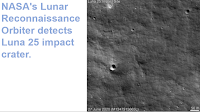Asteroid 2023 SC2 passed by the Earth at a distance of about 173 500 km (45% of the average distance between the Earth and the Moon or 0.12% of the distance between the Earth and the Sun), with a velocity of about 18.46 km per second, slightly after 2. 50 pm GMT on Monday 18 September 2023. There was no danger of the asteroid hitting us, though were it to do so it would not have presented a major threat. 2023 SC2 has an estimated equivalent diameter of 3-8 m (i.e. it is estimated that a spherical object with the same volume would be 3-8 m in diameter), and an object of this size would be expected to explode in an airburst (an explosion caused by superheating from friction with the Earth's atmosphere, which is greater than that caused by simply falling, due to the orbital momentum of the asteroid) more than 35 km above the ground, with only fragmentary material reaching the Earth's surface.
2023 SC2 was discovered on 19 September 2023 (the day after its closest approach to the Earth) by the University of Arizona's Mt. Lemmon Survey at the Steward Observatory on Mount Lemmon in the Catalina Mountains north of Tucson. The designation 2023 SC2 implies that the asteroid was the 53rd object (asteroid C2 - in numbering asteroids the letters A-Z, excluding I, are assigned numbers from 1 to 25, with a number added to the end each time the alphabet is ended, so that A = 1, A1 = 26, A2 = 51, etc., which means that C2 = (25 x 2) + 3 = 53) discovered in the second half of September 2023 (period 2023 S - the year being split into 24 half-months represented by the letters A-Y, with I being excluded).
2023 SC2 is calculated to have a 1072 day (2.94 year) orbital period, with an elliptical orbit tilted at an angle of 4.39° to the plain of the Solar System which takes in to 0.70 AU from the Sun (70% of the distance at which the Earth orbits the Sun, and slightly inside the orbit of Venus) and out to 3.40 AU (3.40 times the distance at which the Earth orbits the Sun, somewhat more than twice the distance at which the planet Mars orbits). It is therefore classed as an Apollo Group Asteroid (an asteroid that is on average further from the Sun than the Earth, but which does get closer).
Asteroid 2023 SC3 is calculated to have had one previous close encounter with the Earth, in October 2020; no further such encounters are predicted at this time.
See also...
Follow Sciency Thoughts on Facebook.
Follow Sciency Thoughts on Twitter.

.jpg)
b.jpg)





